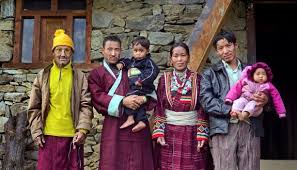In a world dominated by monogamy, the practice of polyandry- a social practice where a woman has multiple husbands, stands out as an uncommon social structure. Although it is illegal in many countries, it has been part of diverse cultures historically. In contemporary India, despite the Hindu Marriage Act forbidding it, some isolated communities still maintain this age-old custom.
The Hatti tribe, residing in the mountainous terrains of Himachal Pradesh, is one such community. The Hattis have maintained the tradition of polyandry for generations, known as “Jodidaran Pratha” or “Draupadi Pratha.” This distinctive practice stems from practicality rather than societal norms. In the Hatti community, where cultivable land is limited and poverty is a stark reality, polyandry plays a vital role in conserving family assets and securing the welfare of the collective family.

Jodidaran Pratha – A marriage of necessity
The Jodidaran Pratha, practiced by the Hatti tribe in Himachal Pradesh, is a type of polyandry in which a woman marries several brothers from the same family. Contrary to the often-romanticized views of polyandry, the Jodidaran Pratha is based on sheer practicality.
The mountainous terrain of Himachal Pradesh offers limited cultivable land. For the Hattis, who depend heavily on agriculture for their livelihood, land fragmentation poses a significant threat. With each generation, dividing the land amongst multiple sons would leave each family unit with insufficient resources to survive. Jodidaran Pratha offers a solution to this problem. By marrying a single woman, all the brothers share marital responsibility and ensure the land remains undivided. This allows the family to maintain a more stable economic foundation.
However, the practice goes beyond just land management. In communities where poverty is a constant struggle, Jodidaran Pratha helps to pool resources. With multiple brothers contributing to the household income, the collective family unit can better meet its needs. This collaborative approach ensures the welfare of all members, particularly children, who are guaranteed a secure upbringing.
Jodidaran Pratha is not without complexities. The practice raises questions about women’s agency in choosing their partners. Additionally, navigating the emotional dynamics of a multi-partner marriage can be challenging for all parties involved. However, for generations, the Hattis have found a way to make Jodidaran Pratha work within their social structure.

The future of the Jodidaran Pratha
Despite its practicality, the Jodidaran Pratha is encountering challenges in today’s world. The social acceptance it previously held within the Hatti community is gradually eroding. As access to education is increasing and the exposure to the broader world growing, the younger generations are beginning to question the tradition.
The economic opportunities beyond subsistence agriculture are luring young Hattis away from their ancestral villages. As they integrate into a society where monogamy is the norm, their aspirations for marriage and family life are shifting. Nuclear families with single spouses are becoming increasingly desirable.
Moreover, the question of women’s agency in Jodidaran Pratha is also gaining traction. While some community leaders claim women hold positions of respect, the practice inherently restricts their choices. With growing awareness of women’s rights, the lack of consent in traditional Jodidaran marriages is a point of contention.
As the Hatti community integrates further with mainstream Indian society, Jodidaran Pratha is fading away gradually.
Conclusion
The story of Jodidaran Pratha offers a glimpse into a distinctive social system driven by practicality and shaped by a harsh environment. It highlights the adaptability of human societies in the face of limited resources. However, it also raises questions about cultural preservation and the balance between tradition and individual rights in a changing world.
Jodidaran Pratha’s decline is a reminder that cultures are not static entities. As societies evolve, traditions adapt or disappear. The future of Jodidaran Pratha maybe uncertain, but its legacy as a testament to human resilience and resourcefulness in the face of adversity is undeniable.



